Goldman Sachs is one of the leading global firms in the field of investment banking, securities, and investment management. Every year, Goldman Sachs opens their Analyst Program, Associate Program, and Engineering Program to recruit new talents. With nearly thousands of applications, Goldman Sachs uses aptitude assessment tools to select the best candidates with the fullest competencies.
In this article, we will cover the in-and-out of the Goldman Sachs aptitude test: the test format, question types, and some recommended practices for you.
Table of Contents
What is Goldman Sachs aptitude test?
Goldman Sachs aptitude test is a series of psychometric assessment tools to evaluate candidates’ cognitive abilities and predict their future performance for the required positions. Goldman Sachs owns one of the most comprehensive aptitude test series, with 66 multiple-choice questions categorized into 6 types of questions. Test takers only allow to do the test in 90 minutes, and can start with any section they want.
/case_thumb/1671776616882_2022_goldman_sachs_aptitude_test.png)
Quantitative reasoning tests:
- Numerical computation: 8 questions
- Numerical reasoning: 12 questions
Logical reasoning tests:
- Deductive reasoning: 12 questions
- Abstract (Inductive) reasoning: 12 questions
- Diagrammatic reasoning: 12 questions
Verbal reasoning test:
- Reading comprehension: 10 questions
Unlike many other large companies, Goldman Sachs does not depend on third-party test providers for their psychometric tests. They create their own question bank for the aptitude tests. But based on the recent test patterns, we notice that Goldman Sachs aptitude test shares similarities to the SHL-style Psychometric Test.
Goldman Sachs verbal reasoning test
Goldman Sachs verbal reasoning test aims at evaluating candidates’ ability to comprehend and draw inferences from written documents, which is highly required when working with financial and legal documents in the firm. The test consists of 2 passages (from 400-600 words) with 5 reading comprehension questions for each passage.
Common question types in reading comprehension of Goldman Sachs verbal test
- Factual question: Find the statements that is absolutely true based on the information of the passage.
- Inference question: Find the statements that can be inferred to by making logical reasoning based on the passage.
- Main idea question: Find the statements that generalize the key points (or purposes) of a passage.
- Vocabulary question: Find the words with closest/opposite meaning with the bold word in the passage.
Example question in the Goldman Sachs verbal test
If you are a perfectionist, you are probably familiar with the feeling of wanting to get everything just right. You may struggle with handing in papers, agonize over projects at work, and even worry about small errors from the past.
High standards are one thing, but perfectionism is quite another. And as some researchers have discovered, pursuing perfection can have serious consequences for both mental and physical well-being.
According to researchers, perfectionists hold themselves to unrealistically high standards and become self-critical if they believe they haven’t met these standards. Perfectionists are also likely to feel guilt and shame if they experience failures, which often leads them to avoid situations where they are worried they might fail. Amanda Rugger explains, “When [perfectionists] don’t succeed, they don’t just feel disappointment about how they did. They feel shame about who they are.”
Although many people see the pursuit of excellence as a good thing, researchers have found that on the extreme end, perfectionism is actually linked to lower mental health. In one study, researchers analyzed how perfectionism was related to mental health. They found that perfectionism was associated with symptoms of depression, anxiety, obsessive-compulsive disorder, and eating disorders. They also found that people higher in perfectionism (i.e. participants who more strongly identified with perfectionist traits) also reported higher levels of overall psychological distress.
Researchers looked at how perfectionism and depression were related over time. They found that people higher in perfectionism tended to have increases in depression symptoms, which suggests that perfectionism may be a risk factor for developing depression. In other words, although people may think of their perfectionism as something that helps them succeed, it appears that their perfectionism may actually be harmful to their mental health.
Is perfectionism always harmful? Psychologists have debated this point, with some suggesting that there can be such a thing as adaptive perfectionism, in which people hold themselves to high standards without engaging in self-criticism over mistakes they make. Some researchers have suggested that a healthier form of perfectionism involves pursuing goals because you want to and not blaming yourself if you fail to meet a goal. However, other researchers suggest that perfectionism is not adaptive: according to these researchers, perfectionism is more than just holding yourself to high standards, and they don’t think perfectionism is beneficial.
In one study, researchers looked at how perfectionism has changed over time. The researchers reviewed previously collected data from over 41,000 college students from 1989 to 2016. They found that over the time period studied, college students reported increasing levels of perfectionism: they held themselves to higher standards, felt there were higher expectations placed on them, and held others to higher standards. Importantly, what increased the most were the social expectations that young adults picked up on from the surrounding environment.
Source: Goldman Sachs
Question: Researchers are yet to decide
A. The extent at which perfectionism becomes harmful.
B. The age group that perfectionism is found mostly in.
C. The time-period where perfectionism began to rise.
D. How higher expectations have led to increased perfectionism.
Answer and Explanation:
In the passage, it mentions that “Is perfectionism always harmful? Psychologists have debated this point…” then follows with a debate about adaptive perfectionism - the non-harmful and motivating type of perfectionism, and when perfectionism becomes not beneficial.
⇒ The answer is A. The extent at which perfectionism becomes harmful.
KEY TAKEAWAY: There are 3 key tips to succeed in reading comprehension questions:
- Enrich your vocabulary resource: Continuously learn and apply new words to make sure you can understand the meaning of at least 90% of the words.
- Skimming and Scanning: Fast reading to get main ideas and reading in detail to locate specific information.
- Read between the line: Draw logical inferences beyond what is written in the text.
We have a comprehensive guide for verbal reasoning tests to introduce these skills and approaches. You can check it out to gain further insights.
Goldman Sachs quantitative aptitude test
Goldman Sachs quantitative test consists of two tests: Numerical computation and Numerical reasoning test. It is used to assess how the candidates demonstrate the ability to work with numbers.
The whole section contains 20 questions, including 8 numerical computation questions and 12 numerical reasoning questions. If you find your strength in numerical problems, you should finish this section first.
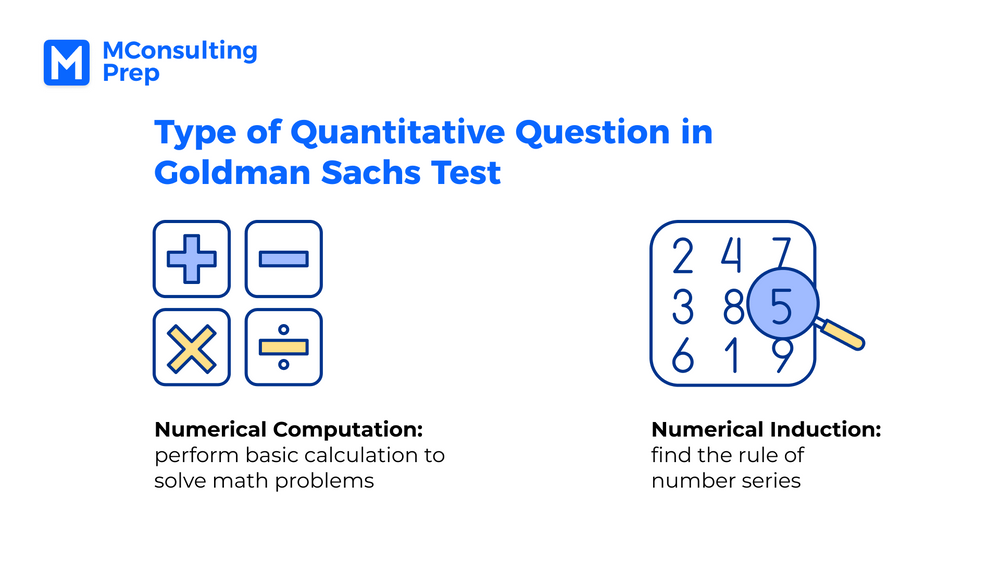
Numerical computation
Numerical computation questions require candidates to perform basic calculations to solve math problems such as Percentage, Ratio, Divisibility, Profit - Loss, Average, Time work, etc.
These tasks are all familiar to most people because they are mostly basic math you learn in university or exam like SAT and GMAT. Our recommendations are:
- Revise all the key terms and formula of Calculus and SAT, GMAT Maths to make sure you would understand the questions.
- Practice with all types of questions to improve accuracy and speed while calculating.
Example:
The rate of people who actually decide to take English courses at Ibest English center when they got to know its fan page (assuming they instantly clicked the “like” button upon knowing the page) is 2%. A marketing campaign costing 40 million VND is projected to help increase the number of its fan page likes by 6,300 likes. The average price of an English course offered at Ibest is 5.3 million VND. After stripping out the cost of the marketing campaign, how much would the campaign, if implemented, generate?
A. 647.8 million VND
B. 637.8 million VND
C. 627.8 million VND
D. 667.8 million VND
Answer: C. 627.8 million VND
The number of people deciding to take English courses after liking the fan page is: 6,300 × 2% = 126 people.
The revenue from these customers is 126 × 5.3 = 667.8 million VND.
The campaign would generate 667.8 - 40 = 627.8 million VND in profit.
Numerical induction
Numerical reasoning questions concern more about how test takers deduce the pattern in a number/letter sequence and choose the correct answer to complete the sequence. This question requires performing inductive reasoning skills. Here is an example of a numerical reasoning question.
Example
Which one of the given options will come in place of the question mark (?) in the following sequence so that it will complete the sequence?
E 25 Y, H 64 W, M 169 U, P 256 S, (?)
Pick ONE option
A. U 441 R
B. V 400 Q
C. U 289 P
D. U 441 Q
Answer: D
We see that each code has 3 parts: the first letter, a number, and the last letter. Therefore we will find the rule for each component.
For the number part, we have 25 = 52; 64 = 82; 169 = 132; 256 = 162
⇒ We can see that 5 + 3 = 8; 8 + 5 = 13; 13 + 3 = 16
⇒ The rule is to add 3 then add 5, and continue like this.
⇒ The next number is (16 + 5)2= 212 = 441
For the first letter, we see:
- E + 2 more letters = H;
- H + 4 more letters = M;
- M + 2 more letters = P
⇒ The next in sequence for the first letter is P + 4 more letters = U
For the last letter, we have the sequence Y - W - U - S, and we can see that it is going backward of the alphabet chart and they skip one letter in between.
⇒ The next after S is Q
⇒ The next in the sequence must be U Q
⇒ The answer is U 411 Q
KEY TAKEAWAY: Solving the numerical reasoning question in Goldman Sachs aptitude test requires one to make inductive reasoning among the letters and numbers. The key to gaining these skills are:
- Practice with some common number/letter pattern to understand the inductive logic.
- Practice extensively and read the explanations afterward to rule out the pattern yourself.
Goldman Sachs logical reasoning aptitude test
Goldman Sachs assesses its candidates’ ability to identify and make logical connections with a series of three tests, including:
- Deductive reasoning (or Puzzle Logical): Make logical deductions from the given general information to reach a specific conclusion.
- Abstract reasoning (or Inductive Reasoning): Identify the logical visual pattern of a set of figure and complete the missing part(s) of the sequence
- Diagrammatic reasoning: Find the rules governing the given diagrams and flowcharts and apply them to deduce a logical output.
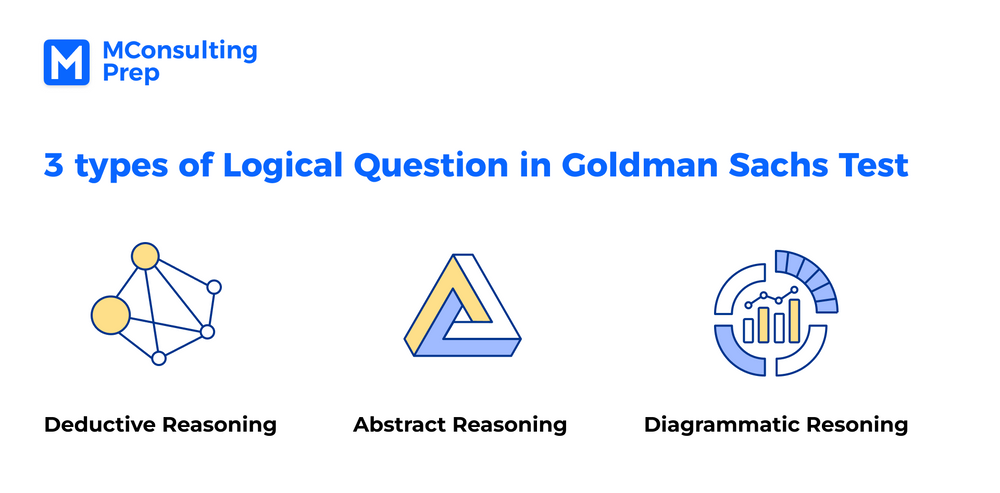
Deductive reasoning
Deductive reasoning questions in Goldman Sachs aptitude test focus on the deduction skills of logical reasoning - one is evaluated based on how they can make a specific conclusion from a set of general facts. In the test, this question types is also called Puzzle Logical Question.
It can be divided into these common question types:
- Order & Arrangement: Seat arrangement or schedule a time calendar.
- Clock and Calendar Sense: Identify the time or date based on the clock and calendar rules.
- Directional Sense: Find the correct direction after following a series of instructions.
- Coding & Decoding: Decipher the coding rules of the letters
Example question of deductive reasoning
A floor of company A has 6 rooms - P, Q, R, S, T, and U. Room P and R have two department each; the rest have only one department each. Eight departments Business, General Management, Marketing, Operations, Finance, Sales, Human Resources, and Legal Department are to be allocated in these rooms.
General Management, Finance, and Legal are departments with only seniors while the rest are only juniors. Departments of seniors and juniors can’t be arranged together in the same room.
- No department of juniors is willing to work in room R or U.
- Business Department wants a whole room but doesn’t want to work in room Q or S.
- Operations Department needs to work in the same room with one other Department but is not arranged in the same room with either Sales or Human Resources.
- Legal Department is not in the same room as any other Department.
Which of the following statements is WRONG?
A. Business Department works in room T
B. Sales Department works in room Q or P
C. Legal Department works in room U
D. General Management and Finance Department will work in room R
Answer and Explanation
We have two entities in the question:
- Six rooms: P, Q, R, S, T and U
- Eight departments: Business, General Management, Marketing, Operations, Finance, Sales, Human Resource and Legal Department
Analysis
- Since room R has two departments each and using clue (1), we can infer that two departments of seniors will work in room R.
- From clues (1) and (2), Business Department works in room T.
- From clues (3) and (1), Operations Department will work in room P with Marketing Department.
- From clues (4) and (1), Legal Department will work in room U.
⇒ General Management and Finance Departments will work together in room R.
- Room Q and S can be either Sales or Human Resources Department in each.
The final arrangement is as follows (as shown in the table):
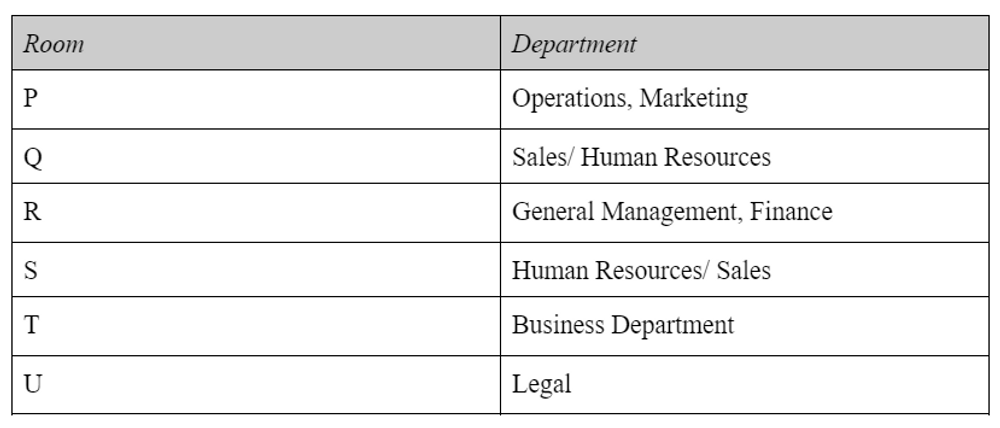
Therefore, Sales Department works in room Q or S, not room Q or P.
Abstract reasoning
Abstract reasoning is a part of inductive reasoning, in which one needs to spot the underlying pattern rules of a set of figures, then fill in the missing part to complete the pattern. Commonly there are three types of abstract reasoning questions
- Identify the feature in common: requires you to identify the feature sample shapes have in common and then choose the answer that shares that feature from the suggested answer shapes.
- Complete the non-verbal series: requires you to identify the common rule shared by a series of shapes, then decide which of the suggested answers is the next step or the missing step in the series with that logic.
- Complete the non-verbal matrix: requires you to look broadly at the whole matrix. It is your task to identify the missing shape from the suggested answer shapes. The shape of the matrix can be varied (square, rectangle, circle, star, polygonal, etc)
Example:
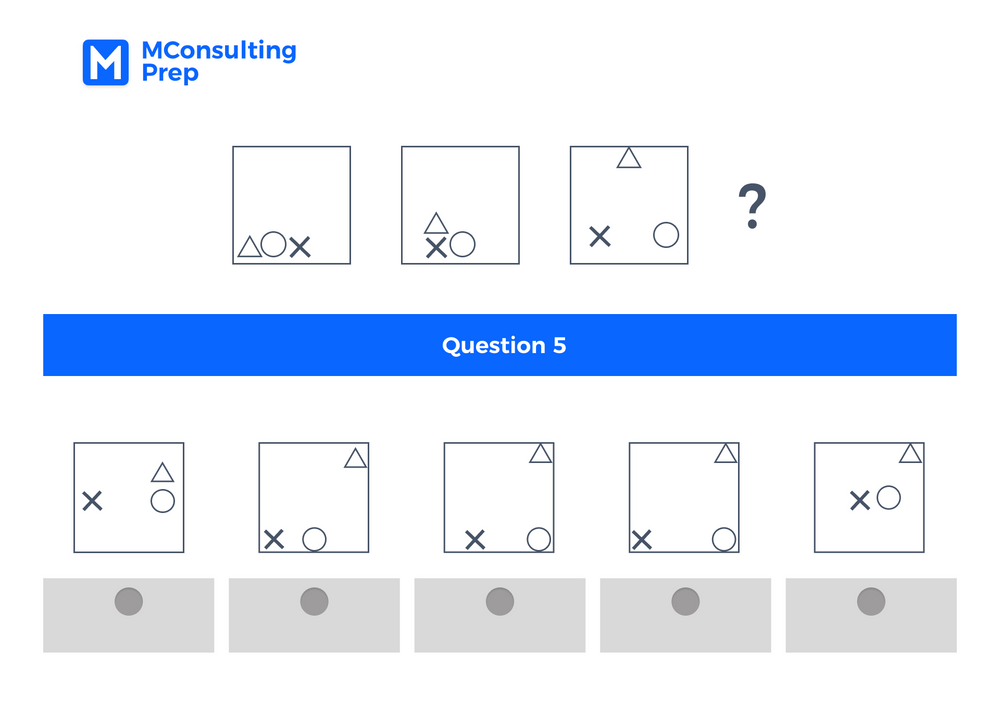
Correct answer: A
Explanation:
Elements: There are three elements: triangle, circle and cross.
Rules: All elements follow the movement rule.
- The triangle moves along the diagonal line of the square with an upward trend.
- The circle moves to the right of the square.
- The cross moves to the left of the square.
Then the missing answer is A.
Diagrammatic reasoning
Diagrammatic reasoning tests assess your ability to think logically and analytically and to solve complex problems. The question comprises a set of diagrams, and your task is to work out the rules of the diagram and find the corresponding output of those rules. The diagrammatic reasoning test is:
- Numerical Puzzles based on Figures Quiz
- Symbol-based Input and Output Quiz
- Flowchart
Here is an example of how a diagrammatic question is presented in a test.
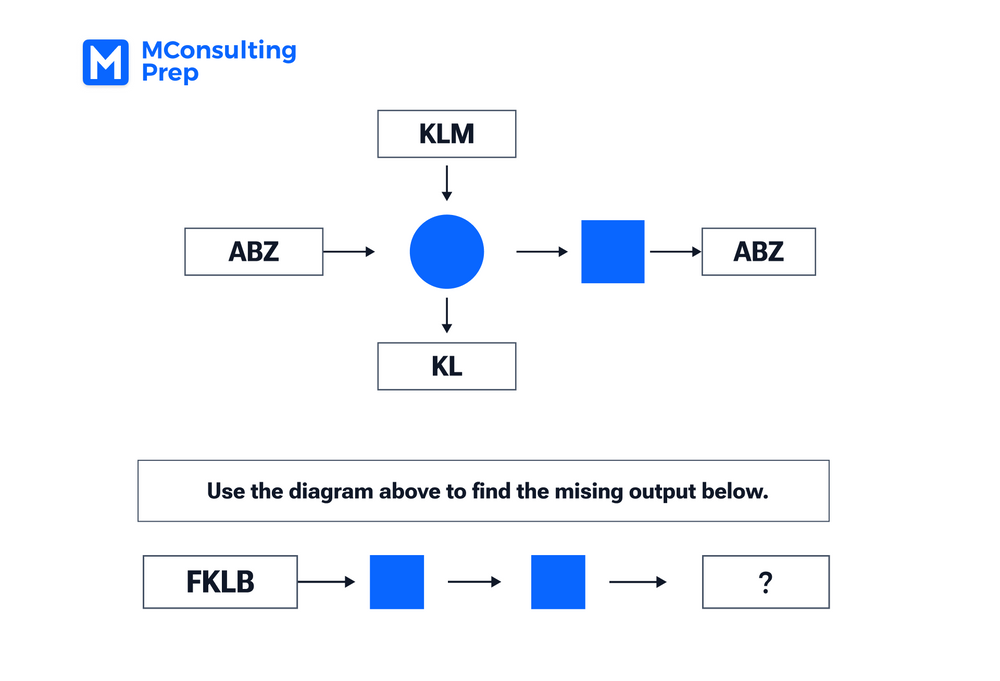
Answer:
The sequence “KLM”, when going through the circle, has the last letter removed from it to have “KL”
⇒ When going though the circle, ABZ would become “AB”
When AB goes through the square, it loses the first letter “A” to only have “B” ⇒ The sequence that going though the square will have the first letter removed.
⇒ For the sequence FKLB, it becomes KLB when going through the first square, then becomes LB when going through the second square.
The answer for the blank question mark is LB.
KEY TAKEAWAY: To completely master the Logical Reasoning test, you must ensure you know the logic model and solving approach of each question type. In addition, to finish the test within the time limit, you should intensively practice the test to reach the goal of completing one question in 60 seconds.
Is Goldman Sachs aptitude test hard?
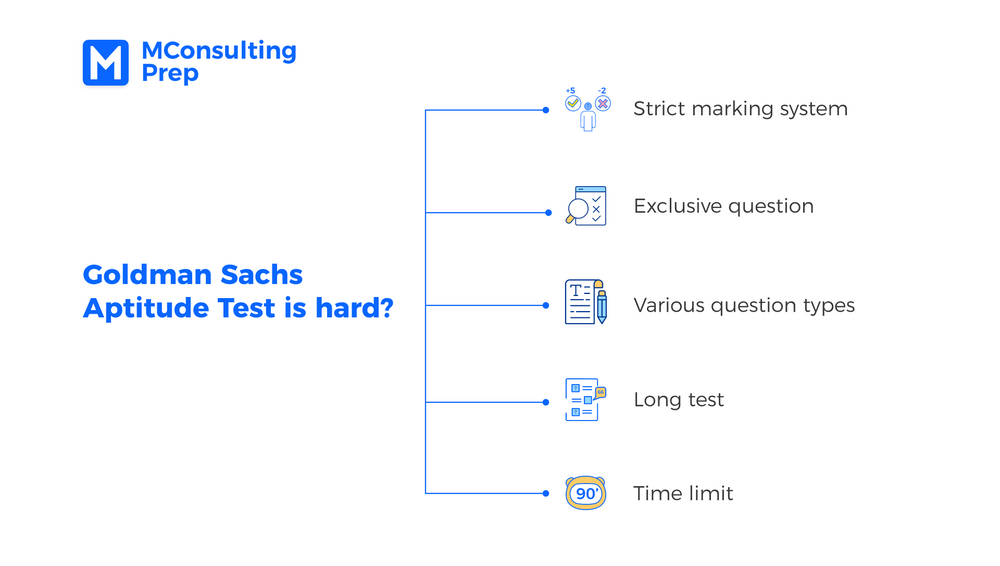
The answer is YES. Goldman Sachs aptitude test is one of the toughest assessment exams for several reasons. MConsultingPrep offers you a solution to a comprehensive shortcut to prepare and practice for Goldman Sachs aptitude test with our All-Inclusive Aptitude Test Package.
Strict marking system
This is the main reason why the Goldman Sachs aptitude test has a high cut-off rate of 75%. You would have 5 points added for each correct answer. On the other hand, your score will be subtracted 2 points for each incorrect answer. The advice for you is to practice thoroughly and early to ensure your accuracy is improving.
⇒ Solution: Our aptitude test packages contain practice questions with a detailed explanation of each question to have you understand the solving steps then increase your accuracy while taking the test.
Exclusive questions in various types
Goldman Sachs creates their exclusive aptitude question bank for the recruitment process. Their question bank contains different types of questions for all 6 aptitude tests. It is impossible to either have the exact test prediction or cram only some question types.
To pass the aptitude exam, you must understand the logic and rules of solving each test and each question type. After mastering the solving way of the test, you need to put them into practice to make sure you can solve the question easily in the real test.
⇒ Solution: Our aptitude test package contains a wide range of practice tests with +1000 questions of numerical, verbal, deductive, and inductive reasoning.
Long tests with limited time
Goldman Sachs aptitude test consists of 66 multiple choice questions for 6 different tests. It is mentally challenging to continuously switch from one test to another and need to finish them within 90 minutes.
Ideally, you should be able to solve each question within 60-70 seconds or less - this is to ensure you would have time to solve the more difficult question, which takes up more time.
⇒ Solution: Our aptitude test package provides you with practice tests with timing (around 15 minutes for a test) to help you get used to the intense atmosphere of the real test. You will also receive a report of your score with full test explanations to help you improve in the next practice.
/filters:quality(75)//case_thumb/public/1699589977462_aptitude_tests_package_4_x.png)